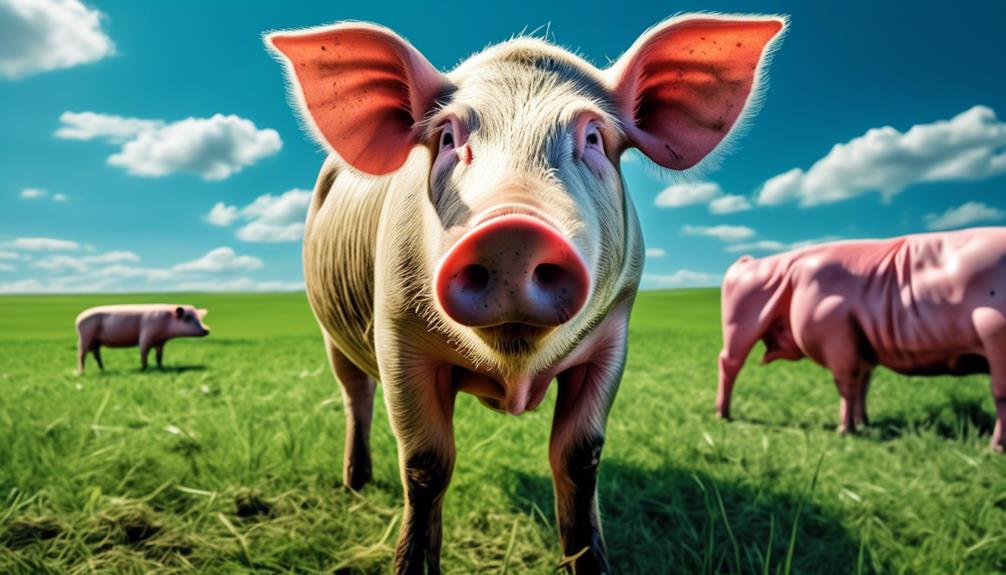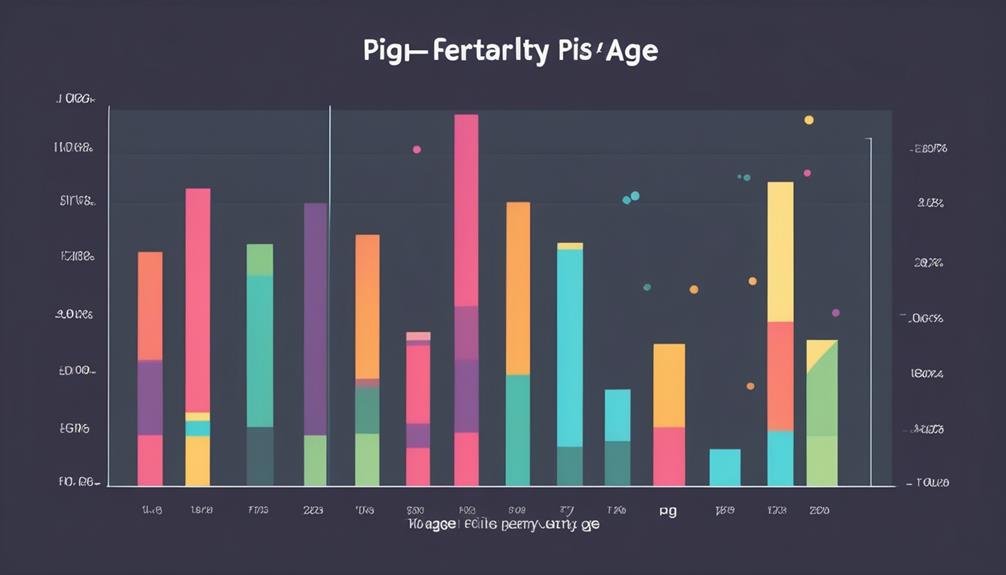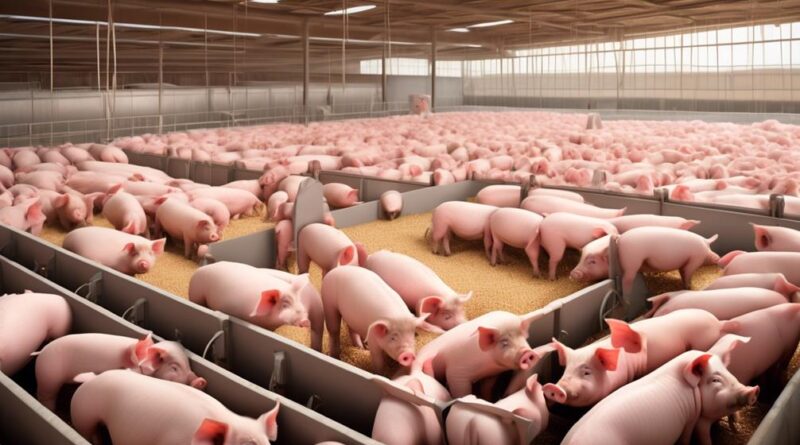Exploring Key Elements Impacting Pig Fertility Rates
You're about to embark on a journey through the intricate web of factors that affect pig fertility rates, much like a detective unraveling clues in a complex case.
As you delve into the world of swine reproduction, you'll uncover the interplay of genetic, nutritional, environmental, and management elements that can significantly impact fertility outcomes.
From the subtle influence of hormonal balance to the profound effects of stress and age, each aspect plays a crucial role in the reproductive success of pigs.
But what exactly are these key elements, and how do they interact to determine the fertility rates of these intelligent and sensitive animals?
Genetic Factors
Genetic factors play a significant role in determining the fertility rates of pigs, influencing their ability to reproduce effectively. Inbreeding effects and genetic diversity are crucial components that impact the fertility of pigs.
Inbreeding, or the mating of closely related individuals, can lead to a decrease in genetic diversity within a population. This reduction in genetic diversity can result in detrimental effects on fertility, as it may increase the prevalence of genetic disorders within the population. Therefore, maintaining genetic diversity through careful breeding selection is essential for ensuring healthy and fertile pig populations.
Genetic disorders can significantly affect the fertility of pigs, emphasizing the importance of breeding selection. Selective breeding programs aim to minimize the occurrence of genetic disorders by carefully choosing breeding pairs to promote desirable traits and genetic diversity. By selecting for specific traits, such as reproductive health and fertility, breeders can mitigate the impact of genetic disorders on pig populations.
Through strategic breeding selection, the fertility rates of pigs can be improved, ultimately contributing to the overall success of pig reproduction.
Nutritional Influences
To ensure healthy and fertile pig populations, paying attention to the nutritional influences on pig fertility becomes crucial, as it complements the efforts to maintain genetic diversity and minimize the occurrence of genetic disorders through selective breeding programs. When it comes to nutritional influences on pig fertility, there are several key factors to consider:
- Dietary Supplements: Incorporating the right dietary supplements into the pigs' feed can have a significant impact on their fertility. Essential vitamins, such as A, D, and E, play a crucial role in reproductive processes. Additionally, minerals like zinc and selenium are known to support reproductive health in pigs. Ensuring that these supplements are included in the pigs' diet can help optimize their fertility.
- Feed Quality: The quality of the feed provided to pigs directly affects their fertility. A well-balanced diet that meets the specific nutritional requirements of pigs at different stages of their reproductive cycle is essential for maintaining optimal fertility rates. Poor feed quality can lead to deficiencies that may hinder reproductive performance, making it imperative to prioritize high-quality feed.
- Nutrient Ratios: Achieving the right balance of nutrients in pig feed is vital for supporting fertility. Protein, carbohydrates, fats, and fiber all play unique roles in ensuring reproductive success. Properly balanced nutrient ratios can enhance the overall fertility of pigs and contribute to healthier litters.
Environmental Conditions
When managing pig fertility, ensuring that environmental conditions are optimal is essential for maximizing reproductive success and overall herd health. Climate variations and seasonal changes play a significant role in pig fertility. Sudden shifts in temperature and humidity can stress pigs, leading to decreased fertility rates and even miscarriages. It's crucial to monitor and control the temperature and humidity levels within the pig housing facilities to provide a comfortable and stable environment for the sows.
Furthermore, the impact of pollution and habitat degradation on pig fertility shouldn't be overlooked. Pollution from nearby industrial activities or agricultural runoffs can introduce harmful substances into the pigs' environment, negatively affecting their reproductive health. Habitat degradation can also lead to increased stress for the animals, impacting their fertility rates. It's important to implement measures to minimize pollution impact and maintain the integrity of the pigs' habitat to support optimal fertility.
Reproductive Management
For optimal pig fertility, it's imperative to implement efficient reproductive management strategies that prioritize the health and well-being of the sows. When it comes to reproductive management, there are several key factors to consider in order to maximize fertility outcomes and improve overall reproductive success:
- Breeding Techniques: Utilizing advanced breeding techniques such as artificial insemination and proper selection of boars can significantly impact fertility outcomes. It's crucial to ensure that the timing of mating is carefully planned to align with the sow's estrus cycle, ultimately increasing the chances of successful conception.
- Reproductive Technology: Incorporating reproductive technologies like ultrasound for early pregnancy detection and monitoring can aid in identifying and addressing any reproductive issues early on, leading to improved fertility rates. Additionally, the use of hormonal synchronization protocols can help in optimizing the timing of breeding, further enhancing fertility.
- Health and Nutrition Management: Proper health and nutrition management play a pivotal role in ensuring optimal reproductive performance in sows. This includes maintaining an appropriate body condition score, providing a balanced diet, and implementing effective disease prevention measures. By prioritizing the overall health and well-being of the sows, the likelihood of successful breeding and higher fertility rates can be significantly increased.
Health and Disease

Optimizing pig fertility through effective reproductive management strategies hinges on maintaining robust health and implementing proactive measures to combat potential diseases within the swine herd. Disease prevention is paramount in ensuring optimal fertility rates among pigs.
Regular vaccinations, biosecurity measures, and proper sanitation practices are essential components of disease prevention in swine herds. By minimizing the risk of illness, pigs are better able to allocate their energy and resources towards reproduction, ultimately leading to improved fertility rates.
Additionally, a strong immune response is crucial for maintaining pig health and fertility. A well-functioning immune system enables pigs to resist and combat potential pathogens that could otherwise compromise their reproductive capabilities. Providing pigs with a balanced diet, adequate housing, and a low-stress environment can help bolster their immune response, reducing the likelihood of disease impacting fertility rates.
It is also important to monitor the health status of the swine herd regularly. Early detection of any potential health issues allows for prompt intervention, minimizing the impact of diseases on pig fertility. Working closely with a veterinarian to develop and implement a comprehensive health management plan is a proactive approach to safeguarding the reproductive potential of the herd.
Hormonal Balance
Maintaining a balanced hormonal profile is pivotal for maximizing pig fertility and reproductive success. Hormonal regulation plays a crucial role in ensuring proper reproductive function in pigs.
Here are three key aspects to consider when it comes to hormonal balance and pig fertility:
- Reproductive Endocrinology: Understanding the intricate interactions between hormones and the reproductive system is essential for optimizing fertility in pigs. Reproductive endocrinology delves into the hormonal mechanisms that drive the estrous cycle, ovulation, and pregnancy in sows. By comprehending these processes, you can take proactive measures to support and enhance hormonal balance, ultimately improving fertility rates.
- Nutritional Influences: Diet plays a significant role in hormonal regulation and reproductive health. Ensuring that pigs receive adequate nutrition is vital for maintaining optimal hormonal balance. Deficiencies in key nutrients can disrupt hormone production and regulation, leading to decreased fertility. By providing a well-balanced diet, you can help support healthy hormonal function and improve overall fertility outcomes.
- Stress Management: Stress can have profound effects on hormonal equilibrium and reproductive performance in pigs. Environmental stressors, such as overcrowding, excessive noise, or abrupt changes in routine, can disrupt hormonal regulation, leading to decreased fertility rates. Implementing strategies to minimize stress and create a harmonious environment for the animals can positively impact their hormonal balance and, in turn, enhance fertility.
Age and Parity

Understanding the impact of age and parity on pig fertility is crucial for maximizing reproductive success. As sows age, their reproductive performance may decrease, affecting their fertility potential. Younger sows generally exhibit higher fertility rates compared to older sows. Age-related decline in fertility is attributed to factors such as a decrease in the number of viable oocytes and changes in the uterine environment.
Additionally, parity, or the number of times a sow has farrowed, also plays a significant role in fertility. Primiparous sows, or those that have given birth for the first time, may have lower fertility potential compared to multiparous sows. This could be due to factors such as uterine immaturity and insufficient reproductive experience.
As sows age, their reproductive performance may decline, impacting their ability to conceive and maintain pregnancy. This decline in fertility potential can result in reduced litter sizes and longer intervals between farrowings. It's important for pig farmers to consider these age and parity-related factors when managing their breeding herds.
Implementing strategies to optimize the reproductive performance of older and primiparous sows, such as nutritional management and strategic breeding programs, can help mitigate the potential decrease in fertility rates associated with age and parity. By understanding and addressing these factors, farmers can work towards maximizing the overall fertility potential of their pig herds.
Stress and Handling
Minimizing stress and proper handling are essential for maximizing pig fertility rates and reproductive success. When it comes to stress and handling, it's crucial to consider the impact of these factors on the overall well-being of your pigs. Here are some key considerations to keep in mind:
- Behavior Modification: Implementing strategies to modify the behavior of pigs can help reduce stress levels and improve fertility rates. By providing enriching environments and allowing for natural behaviors, such as rooting and foraging, you can help alleviate stress and create a more conducive reproductive setting for your pigs. Additionally, establishing consistent routines and minimizing disruptions during feeding and handling can contribute to a calmer and more predictable environment for the pigs.
- Stress Reduction: Identifying and addressing sources of stress within the pig production environment is vital for optimizing fertility rates. This can involve minimizing exposure to loud noises, maintaining comfortable temperature levels, and ensuring adequate space and social dynamics within the herd. Furthermore, proper handling techniques, such as using low-stress animal handling methods, can significantly reduce the anxiety levels of pigs and promote overall reproductive success.
- Health Monitoring: Regular health assessments and monitoring can help detect and address any potential sources of stress that may be impacting pig fertility. This includes proactive measures to prevent and manage diseases, as well as ensuring that nutritional needs are met to support optimal reproductive health.
Frequently Asked Questions
How Do Social Dynamics Within a Pig Herd Impact Fertility Rates?
In a pig herd, social hierarchy influences mating behavior, which can impact fertility rates. Dominant sows typically have better access to mating opportunities, affecting overall breeding success. Understanding and managing these dynamics is crucial for optimizing pig fertility.
What Role Do Seasonal Variations in Temperature and Daylight Play in Pig Fertility?
Seasonal breeding in pigs is influenced by temperature variations and daylight exposure. Reproductive hormones respond to photoperiod effects, impacting fertility regulation. Understanding these factors helps optimize pig fertility rates and breeding success.
Can the Use of Artificial Insemination Affect Pig Fertility Rates?
Yes, artificial insemination can impact pig fertility rates by allowing for genetic selection and the use of advanced reproductive technology. Proper nutritional management and strategic breeding methods can further optimize fertility outcomes in pig production.
Are There Any Specific Behavioral or Psychological Factors That Can Impact Pig Fertility?
Specific behavioral stress, social hierarchy, and environmental enrichment can impact pig fertility. Understanding how these factors affect reproductive behavior is crucial for improving fertility rates. It's important to consider these elements in pig farming practices.
How Do Different Housing and Handling Systems Affect Pig Fertility?
Different housing and handling systems can impact pig fertility. Nutrition impacts fertility, with proper feeding supporting reproductive health. Environmental stressors like temperature and noise levels also play a role. Providing a comfortable and low-stress environment is crucial.
Conclusion
In conclusion, understanding and addressing key elements impacting pig fertility rates is essential for successful pig farming.
Genetic factors, nutritional influences, environmental conditions, reproductive management, health and disease, hormonal balance, age and parity, and stress and handling all play a critical role in pig fertility.
By implementing proper management practices and ensuring optimal conditions, farmers can improve fertility rates and ultimately increase productivity and profitability in their pig operations.
